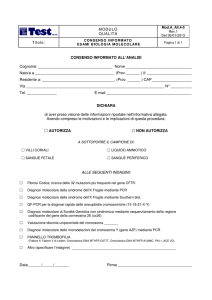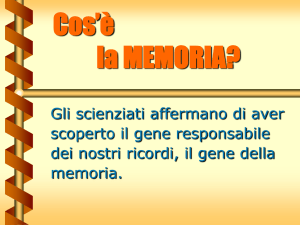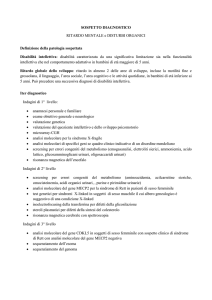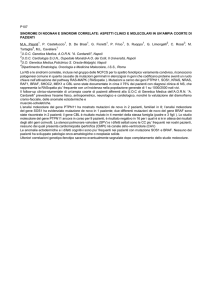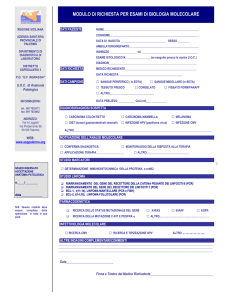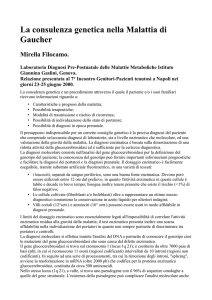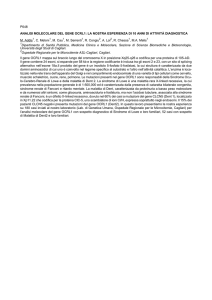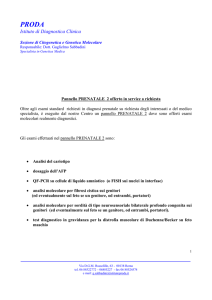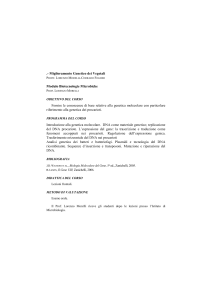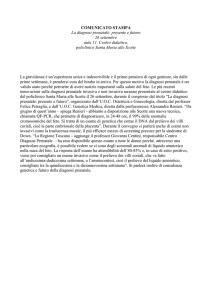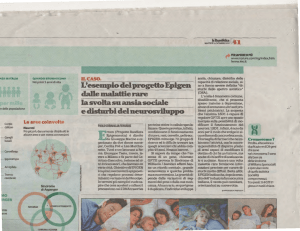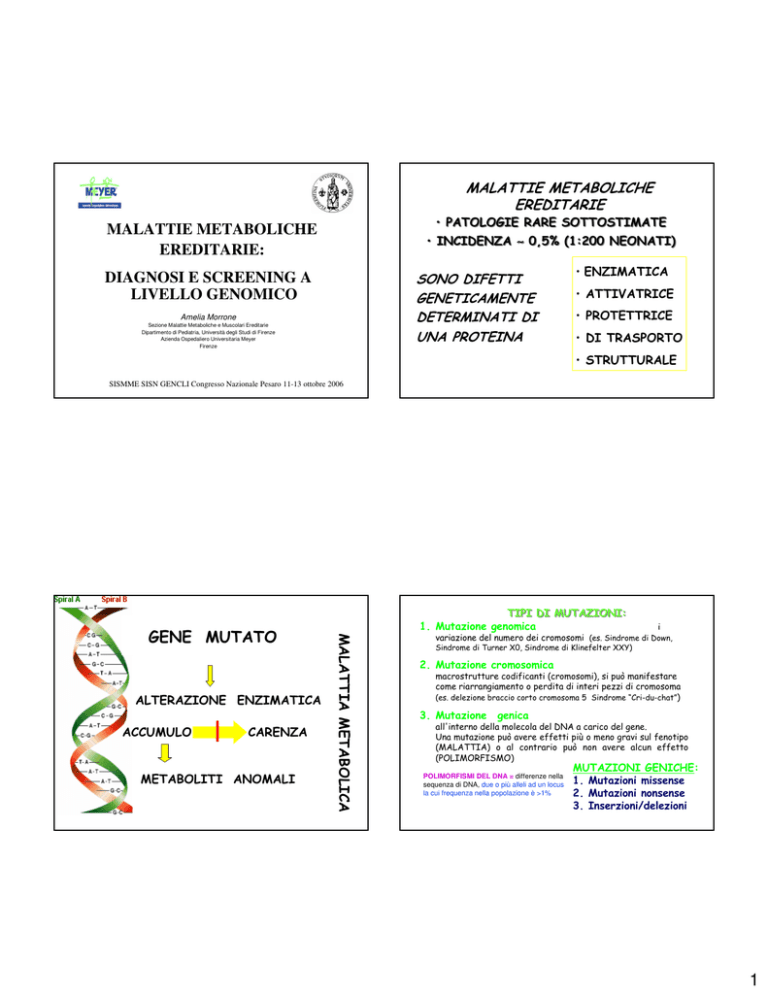
MALATTIE METABOLICHE
EREDITARIE:
∼
DIAGNOSI E SCREENING A
LIVELLO GENOMICO
Amelia Morrone
Sezione Malattie Metaboliche e Muscolari Ereditarie
Dipartimento di Pediatria, Università degli Studi di Firenze
Azienda Ospedaliero Universitaria Meyer
Firenze
SISMME SISN GENCLI Congresso Nazionale Pesaro 11-13 ottobre 2006
!"#$%&' ('&%) $*"
!"#$%&' *+%) %,%) $*"
!
"
#
-
!"#$%&'
$
%& '
' (
)
('&$*"
*
+,
!
/ ,0, 1,
23 01/ 3 4 51 / 3
"
.
"
!
POLIMORFISMI DEL DNA = differenze nella
sequenza di DNA, due o più alleli ad un locus
la cui frequenza nella popolazione è >1%
-
!"#$%&$ ) $,,'&,'
!"#$%&$ &%&,'&,'
&,'+#$%&$./'0'#$%&$
1
Gravità delle mutazioni
assenza o presenza
della proteina coinvolta
attività enzimatica residua
Fenotipo Clinico
MALATTIE METABOLICHE
MALATTIE METABOLICHE
STESSA MUTAZIONE
ETEROGENEITA’ FENOTIPICA
STESSA FAMIGLIA
IMPORTANZA DI ALTRI
FATTORI GENETICI E
AMBIENTALI
4 ,21 ,
1,6+3 1
clinicamente eterogenee
diversi organi e apparati
possono essere coinvolti
spesso presente
danno neurologico
#
4 1 ,4 3 3 +3 + & 3 4 4 7
"
,
1,6+3 1
#
"
2
Malattia Metabolica
conferma diagnostica
BIOCHIMICA
Dal 1980 al 2006
MOLECOLARE
identificazione di numerosi difetti
genetici molecolari alla base delle
malattie metaboliche
RUOLO DELLA ANALISI GENETICO
MOLECOLARE NELLA
DIAGNOSI
DI MALATTIA METABOLICA
3
•DEFICIT DI ENZIMI TESSUTO SPECIFICI
•DEFICIT DI PROTEINE STRUTTURALI
CONFERMA DIAGNOSTICA
•DIAGNOSI PRENATALI
IDENTIFICAZIONE PORTATORI
•DIAGNOSI POSTMORTEM
DIAGNOSI PRENATALE
•DATI BIOCHIMICI DUBBI
CORRELAZIONE GENOTIPO/FENOTIPO
NH3
MITOCONDRIO
HCO-3
carbamilfosfato
CPS I
"+1") $0 %,2"!%
NAG
ACIDO
GLUTAMMICO
NAGS
OTC
-3-
8
CITRULLINA
'%&"!"0'
&2"&!$0'
,%+/$%
HHH LPI
/$
$&!'!",$
%&2'+) " $"(&%,$ $%*4$) $*"
%,"(($% '&#$) "!$*% , 1$%5,$" '5"!$*"
ACIDO ASPARTICO
ORNITINA
AS
UREA
A
& 2 9: 1
&
6
ACIDO
ARGININO-SUCCINICO
ARGININA
AL
CITOPLASMA
ACIDO FUMARICO
;<=$
*
6
('&'
"
Summar et al. 1995 Cytogenet Cell Genet)
(Hoshide et al 1995 Genomics)
15
-7 ',%&$
2
(Haraguchi et al Gene 1991)
81
81
5 "( et al Hum Mut 2003)
(Haberle et al Hum Mut 2003)
(Summar et al 2003 Gene)
(
4
9;; $
B ==D4
, (
;
9
4 A$ B
, (
0A?=
, (
> =D$
, (
;
;
1(
(
*
: 3
9@ @ @
ANALISI MOLECOLARE GENE CPS1
9
99C D4
2003-2006
9
+9 9C
-:
9@ @ =
;
9
:: ; ::
&(4$&$
-
$??/
5 E( 9@@ A
@ 9A2
F E
<7
&(4$&$
STUDIATI 8 PAZIENTI
: -A
/ '0
;A +
B
> ??
#
;
?
= @
A "B !"&$
-
CONFERMA DIAGNOSI CPS1
:
(IDENTIFICAZIONE MUTAZIONE GENE CPS1 )
?
F
-
:
= 3
+, $ @
6
E
; ?
7
>
-
7 6
%,4$/'
F
D
>>-
+, @ =;
E
;
:
=
3
C
"1'+0'
>
-
D
:
AD$7
B #
?
) !"#$%&$ $/'&!$2$*"!' "/ %(($
/'0'!$%&9
+%,, '0'!$%&,9
%E'
7
3 C
;
:
=
3
D
7
> - -
-
> C
"1'+0'
- $,,'&,'.&%&,'&,'9 :
+%,, &,'+,$%&
!"#$%&$ /'&!$2$*"!' $&
-: C
"1'+0'
D
-?
D
:
:
G 99?96
F E
?
-= -3 -7
-- -: -
;
50$*$&(9
DIAGNOSI PRENATALE CPS1
2003-2006 n. 4
9
) "00
"#$'&!$ !"0$"&$
3 maschi
5 femmine
SEGREGANTI
IN 7 FAMIGLIE
1°Famiglia
Diagnosi Probando 2002
Diagnosi Prenatali
Marzo 2003: Feto Affetto
Ottobre 2003: Feto Sano
Aprile 2006: Feto Portatore
2°Famiglia
Diagnosi Probando 2005
Diagnosi Prenale
Agosto 2006: Feto Sano
/'&!$2$*"#$%&' /$ 2') ) $&' 5%+!"!+$*$
? $0 5$F *%) &' /'$ / $2'!!$ / '0 *$*0% /'00? +'"
'0 E
7+H 1/ , 3 & 7 24 7
3 1+ 576, 3 7 1+ 7
1+3
N
N
('&'+"0) '&!' ) %+!"0'
P
S
S/P
-
@6
%&2'+) " $%*4$) $*" '2$*$!
/%,"(($% '&#$) "!$*% , 1$%5,$" '5"!$*"
'&'
) "55" $& @ 5
)
"
=@ ? I&
= &!
%+$*4 '! "0 *$'&*'
>7:
5+%!'$&" /$ - :
5
ANALISI MOLECOLARE GENE OTC
2000-2006
STUDIATI 79 PAZIENTI
33 maschi
46 femmine
""
"
>
=<
CONFERMA DIAGNOSI OTC 24 maschi
22 femmine
(IDENTIFICAZIONE MUTAZIONE GENE OTC)
*33637$&,
46 FAMIGLIE
3
7>/'0
* :/'0
42 famiglie probandi
41 famiglie probande
Portatrici
identificate
0 #
"
23
10
33
portatrici
2: femmine portatrici
2: femmine sana
5: maschi sani
1: maschio affetto
$,"&#$ '! "0
-
>7>
< --@
'$,4 '! "0
>
>>-
> <
+%) 5' '! "0
>>
=
*4 ) "& ' ! "0
: <
> @
+%) 5' '! "0
G %% '! "0
>>:
"/ / "0'&" ' ! "0
>>
"
?C
Conferma diagnostica del difetto nel probando
Identificazione dei portatori
Correlazione genotipo fenotipo
+" '! " 0
-
>>3
@
*4 ) "& ' ! "0
>>-
7C
,
>>-
D
' ! "0
76
=:
(
>>
=7
>>
%,4 $/' '! "0
"!,
4
+&$!$&"
è un mezzo poco invasivo rispetto al dosaggio
enzimatico, che necessita della biopsia epatica, e
permette:
$) ) '+ '! "0
>
*4 ) "&" ' ! "0
>>
-?
=>
>>3
"+*$" '+'#
=-
=
*4 ) "& ' ! "0
>
7
'$1 &/ ( ! '! " 0
>>
-/ '0
7>/'0
33A
7
*4) "& '! "0
37
>77
=
$%+($ '! "0
$&B' 0,!'$& '! "0 >>
3
>>7
A
$%+($ '! "0
:>
:
8 77
-@
+%) 5' '! "0
-= 8
=-
-
6- D
"+1") $0 %,2"!%
DIAGNOSI PRENATALE
'00" '! " 0
=
>78
=3A
=7
=7
9@ @ D
$,"&#$ '! "0
550$('+6 '$1 &/( ' ! "0
>>3
DIAGNOSI PRENATALE
2001-2006 Effettuate n. 10
"
$,"&#$ '! "0
?
Analizzati
83
membri a rischio
<
"" J ;$
79 FAMIGLIE
>>
D
>>-
3 &
3 &
/$
$&!'!",$
+"&,*"+1") $0",$
// 1/
1/ ;=D=
;=D=
// 1/
1/ =99;$
=99;$
è un mezzo poco invasivo rispetto al dosaggio
7
&2 9 che3 necessita
&
5 "epatica,
1 e
enzimatico,
della biopsia
permette:
1,6+3 1 24 7+, ,07
Conferma diagnostica del difetto nel probando
Identificazione dei portatori
3Correlazione
,6613 7+H 1/ genotipo
, 1& 3
fenotipo,+,01 1 / 3 07& 3 0,4 7
DIAGNOSI
K13 2 1,PRENATALE
72, 1&, 57 ,07
+, 1 3 0, 3
, & G 3 ,5
6
CONDIZIONI NECESSARIE PER ESEGUIRE
DIAGNOSI PRENATALE MOLECOLARE
CONOSCERE MUTAZIONE NEL PROBANDO
IDENTIFICAZIONE MUTAZIONE NEI GENITORI
(PORTATORI)
6
1
"
"
-
C
"
"
$*%E'+% " = ) ',$
"
"
#
4 $ AF
MN'
#
%+!' $& 5%*4$ ($%+&$
,
FETO
FETO
FETO
AFFETTO
portatrice
AFFETTO
DNA da Amniociti
FETO
PORTATORE
FETO
FETO
SANO
SANO
"
"
:
/&
RICERCA MUTAZIONI NOTE NEL DNA FETALE
1
di
FRUTTOSIO (200mg/kg)
D
7A
C .C
cDNA ∼1.6 kb; Protein: 364AA
Gene Map Locus 9q21.3-22.2
INCAPACITA’ DI METABOLIZZARE
IL FRUTTOSIO
p.M1T
MUTAZIONI
GENE ALDOB
9q22.3
ALA149PRO
ALA174ASP
ASN334LYS
RESPONSABILI DEL 85%
DEI CASI DI HFI
(Ali,1994)
(Ali,1993)
Ex 2
(Santer,2005)
p.I73T c.325-1G>C
(Esposito,2004)
Ex 3
(Brooks,1994)
p.A174D
p.R134C
(Esposito,2004)
p.R59X
ANALISI MOLECOLARE GENE ALDOLASI B
CONFERMA DEL SOSPETTO DIAGNOSTICO
(14,5kb)
c.345_72del28
p.R3X
CONFERMA DIAGNOSTICA: DOSAGGIO
ENZIMATICO SU BIOPSIA EPATICA
Ex 1
HFI è geneticamene eterogenea:
sono state descritte ∼ 40 mutazioni nel
gene ALDO B
B 0&
+,
*
MALATTIA AUTOSOMICA RECESSIVA
TEST DA CARICO e.v.
2
%,5'!!% /$"(&%,!$*%
# L
INTOLLERANZA EREDITARIA AL FRUTTOSIO (HFI)
Deficit ALDOLASI B
enzima epatico
4 $ AF
MNM
4 $ AF
MNM
6
DNA isolato da CVS
4 $ AF
MN'
(Brooks,1994)
Ex 4
Ex 5
p.Q110X
p.A149P
(Esposito,2004)
c.360_363del
CAAA
p.V221F
Ex 6
(Ali,1994)
p.C177R
(Santer,2005)
2005-2006
CONFERMA DIAGNOSI HFI
(IDENTIFICAZIONE MUTAZIONE GENE ALDO B)
p.N334K
p.R303Q
(Cross,1990)
(Santamaria,2005)
Ex 7
p.L256P
p.C239X
(Ali,1994)
(Kajihara,1990)
Ex 9
Ex 8
c.865delC
p.L283P
(Santer,2005)
(Ali,1995)
STUDIATI 13 PAZIENTI
(Santer,2005)
(Esposito,2004)
(Esposito,2004)
(Santer,2005)
IVS6-1G>A
c.841_42delAC
p.L228P
(Esposito,2004)
p.Y204X
(Cross,1998)
p.W147R
(Santer,2005)
c.625-2A>G
(Cross,1990)
(Santer,2005)
p.A337V
(Ali,1998)
p.R303W
(Tolan,1995)
c.1044_1049delTTCT
GGinsACACT
SEGREGANTI IN 10 FAMIGLIE
(Santer,2005)
12 Pazienti
Ala149Pro 76% alleli esaminati
MUTAZIONI IDENTIFICATE
Ala174As 18% alleli esaminati
Asn334Lys 6% alleli esaminati
7
/ 1/ ;$C$?
/
#
β'"
N
22& ,
+
=9
"
D
* =
"
C
D
* = /'0
"
:
7O
""
α'
L&
:
:
N
""
5
5
5
"
N
β'"
"
2K6,
α'
&G
,5
/'0
: $/+%5'
;D
1 , ;'=
#
:
",'
:
C
78
"
3 "
'
/$
"
9A
"
B
β'6
"
"
"
"
*"
7 "
2'!"0'
2
=
L
7
"
, 22&,
&
7
0"+$"
6
7 "
;$
$/+%5' 2'!"0'
2
"
"
7O
9$ "
"
α'
1G ;M96I
C
6
$; "
!!$E$!H '&#$) "!$*" $& 2$1+%10",!$
0
1
"
β'6
α'+
:
:
Genetic and biochemical prenatal diagnosis
was performed at 11 weeks of gestation in a
family with a proband affected by mut
methylmalonic
aciduria
(MMA)
and
homozygotes for the MUT gene c.643G>A
(p.Gly215Ser) mutation
-"
$"(&%,$ 5%,!6) %+!')
'&#$) "!$*" C ) %0'*%0"+'
6.6
8
T
I
L
L
T G/S T I
T
G T
I
G>A
MUT Gene
new c643G>A
(G215S)
A
G
B
C
AFFECTED FOETUS
L T S
c643G>A
1
&='
P
"
/
(P
1
A
PARTIAL NUCLEOTIDE SEQUENCE OF EXON 2 OF MUT GENE
1
NORMAL FOETUS
1
&
(
5
/
&
5 (
1
?DA#
=;C #
9$;#
DETECTION OF THE G215S MUTATION BY
KpnI RESTRICTION ANALYSIS
Analisi genetico molecolare
PROBANDO
identificazione
ACYLCARNITINE PROFILE IN LC/MS/MS:
High level of C3-propionyl carnitine in amniotic fluid of
the affected foetus was dectected Quantitative analysis
was done using 32H-propionylcarnitine asIS
/
(P
AMNIOTIC FLUID ORGANIC ACID ANALYSIS PERFORMED IN
GC/MS AND QUANTIFIED BY SELECTED ION MONITORING (SIM
The presence of high levels of methylmalonic acid and
propionylcarnitine
determined
by
gas
chromatography/mass spectrometry and LC/MS/MS
analysis, respectively, and the identification of the
p.Gly215Ser at a homozygous level in foetal DNA
allowed a certain, rapid and early diagnosis
UNIPARENTAL DISOMY (UPD)
two copies of a specific chromosome only from
MUTAZIONE IN OMOZIGOSI
(PATOLOGIA AUTOSOMICHE RECESSIVE)
CONFERMA NEI GENITORI
MATERNAL UPD
HETERODISOMY:
PER
ESCLUDERE
PRESENZA DELEZIONI /INSERZIONI
parent passes on one copy of each
homolog (non disjunction in meiosis I)
MUTAZIONI DE NOVO
DISOMIA UNIPARENTALE (UPD)
PATERNAL UDP
UPD can occur as a random event during the formation of egg or sperm cells or
may happen in early fetal development
ISODISOMY:
parent passes on two copies of the same
chromosome (non disjuntion in meiosis II)
UPD may cause health concerns for two possible reasons:
-Parental imprinting in the case of heterodisomy and isodisomy
-The unmasking of recessive conditions in some cases of isodisomy
from www.medgen.ubc.ca
da www.medgen.ubc.ca
9
Malonic aciduria
16q24
c.84-108del
(MIM 248360)
p.G3D
c.475delG
(Wightman, 2003)
Very rare autosomal recessive disorder due to deficiency of malonyl-CoA
decarboxylase, that catalyzes the decarboxylation of malonyl-CoA to acetyl-CoA.
Accumulation of malonyl-CoA that is a powerful inhibitor of carnitine
palmitoyltransferase I (CPT I), causing the impaired fatty acids β -oxidation in
both mitochondria and peroxisomes
p.S187X
(Wightman, 2003)
(Wightman, 2003)
GC/MS urinary organic acid analysis showed high excretion of malonic, methylmalonic,
succinic, adipic, and suberic acid, suggesting a malonyl-CoA decarboxylase deficiency
confirmed by a reduced Malonyl-CoA decarboxylase activity in cultured fibroblasts.
After introduction of a high carbohydrate and low fat diet supplemented by high doses of
carnitine general conditions of our patient, including cardiomyopathy, rapidly improved to
almost normalization and a progressive reduction of the urinary organic acids excretion
was observed
The child suddenly and unexpectedly died at the age of 4 months and 15 days.
(Fitzpatrick, 1999)
(Wightman, 2003)
Ex 2
p.Y131X
(Krawinkel, 1994)
p.M40T p.A69V
(Wightman, 2003)
p.L161P
(Wightman, 2003)
Ex 3
c.634insA
(Wightman, 2003)
Ex 5
Ex 4
c.1151-1159del
(Wightman, 2003)
c.772-775del
(Wightman, 2003)
(
The patient present with classical clinical phenotype with vomiting, hypoglycemia,
metabolic acidosis, cardiomyopathy and development delay
IVS4-14 A>C
c.638/641del
(Haan, 1986)
ExEx
1 1
c.59insC
(Fitzpatrick, 1999)
( /0 &
"
"
A novel c.772-775del deletion resulting in premature truncation of the protein, that
certainly represents a loss of function correlating with the severity of the patient’s
phenotype, was detected at homozygous level
The mother was heterozygous for the same mutation but his father was not carrier
The father’s paternity was confirmed by analysis of polymorphic microsatellite repeats
A maternal uniparental disomy (UPD) was hypothesised
MALATTIE METABOLICHE
in order to test the hypothesis of maternal uniparental disomy (UPD) 14 markers of
chromosome 16 were analysed
Segmental maternal UPD was detected. Maternal isodisomy of 16q24 led
to homozygosity for the mutant allele causing the patient’s disease.
UPD can dramatically reduce the risk of recurrence, we would like to stress
the importance of analysing parental DNA in the presence of homozygosity
for genetic counselling
SCREENING GENETICO
MOLECOLARE DI MASSA
ETEROGENEITÀ GENETICA
screening molecolare di difficile applicazione se non
limitatamente a popolazioni a rischio per patologie più
frequenti e con limitata eterogeneità genetica
COSTO
10
MALATTIE METABOLICHE
PREVENZIONE
Screening neonatale:
POSITIVO
Famiglie a rischio
Identificazione dei
portatori
Conferma diagnostica
Gruppi Etnici
Biochimica
Consiglio Genetico
Analisi genetico molecolare
Diagnosi Prenatale
'2$*$'&*I
/
(
P '& ,
(P
,
"
#
/ &,
&
P
' O
P
(
P
(
4+%) %,%) '
/ &,
=P
D
=3
*-
G =3
2
3
6
:7
,
"
"&/') ) ",, ,5'*!+%) '!+I
.
.
) '", +', %*!"&%I0*"+&$!$&' %& 2$0!'+
5"5'+ 10%%/ ,5%!
-
7
8
-C
D
>3
>-
7
3
-C
D
*-73/'0
G
G
7@
7
*
6
/'0
-3
c.985A>G
(88 - >
8- :
10
9
G-
-7:@
11
12
D
: C :/'0 $&,
-@
=
=
- =
-:>@
7
6
I5%(0I*') $"
%) $!$&(
'!4"+(I
&*'54"0%5"!4I
',5$+"!%+I /$,!+',,
'5"!%) '("0I
'$# +',
5&'"
"+/$"* 2"$0 +'
%) "
//'& J &'K5'*!'/ /'"!4
$&,
>:
>
:>
5
4
=3
>-
::@
#
1
::
6- = /'0
* ::$&,
, 6
"(
(
3
:-6
(
*>>>6
==
=G
P
P
=P
5-
P
7
- =
-3
--=
--:
LE MUTAZIONI SONO NUMERATE A PARTIRE DALL’ATG
) %0'* 0"+ "&"0I,$,
,5'*$2$* ) !"!$%&,
%&2$+) "!$%&
2%+
-:
6
G
G 6 %
"
11
*>7
D
8- >
8
POPOLAZIONE CAUCASICA
*>7
D
Esperienza australiana
34:592.785
80% omozigoti per c.985A>G
1:20.000
C .C
8
Waddell L et al. Mol Gen Metab 2006 87:32-39
Su 8.2 milioni
di neonati
47-80% omozigoti per c.985A>G
1:14.600
Rhead J Inherit Metab Dis 2005 29:370-377Rew
Esperienza Toscana dal Gennaio 2002 a Ottobre 2006
3:106.659
1:40.000
2 pz italiani omozigoti per c.985A>G
Estrazione del DNA da 3
punzonature ( 2.8 mm)
dello spot di sangue
Resa DNA :
5 ml di sangue circa 250 µg
200 ul di sangue mini Kit 4-12 µg
C .6
8
C .6
Amplificazione del
frammento desiderato
mediante PCR
1 pz albanese omozigote per la c.244ins(T)
ESTRAZIONE E CONSERVAZIONE DNA
PER STUDI GENETICO- MOLECOLARI
POSSONO ESSERE ESEGUITI DA
SANGUE
MATERIALI BIOPTICI
FIBROBLASTI
ALTRO MATERIALE BIOLOGICO
Per qualsiasi tipo indagine genetico
molecolare è necessario
CONSENSO INFORMATO
PER TEST GENETICI
LIMITI DELL’ANALISI MOLECOLARE
Correlazione del significato di lesioni geniche introniche
o che che portano ad eventuali sostituzioni aminoacidiche
identificate in forme mild o allo screening neonatale
NECESSARI
Studi funzionali aggiuntivi, cellulari, espressione
genica, analisi bioinformatiche e accuratissima
valutazione e/o rivalutazione clinico strumentale
attività enzimatica residua elevata
MUTAZIONE MILD O POLIMORFISMO PSEUDODEFICIENZA
12
G
'
E
P
#P
MUTATIONS IDENTIFIED IN GLA GENE OF
ITALIAN FABRY PATIENTS
// 1/
1/ == 9$
9$
"
P
P
$& :
"P
( "
#
α'6,0,& 3 1 , 7 , α'6,0 ,
A
) "0',
B
4
6 ,
100 % IN MOST REPORTED PAPERS
97,6 % Schafer et al 2005 (82/84)
94,4 % OUR WORK
P
L
P
3 FABRY FEMALE PATIENTS
BY SEQUENCE ANALYSIS
C
α'
53 FABRY CARRIERS
GLA MUTATION DETECTION RATE
G
2(
In 2 of 36 patients (<1% α-GLA) no
mutation identified
34 FABRY MALES
17 suspected
Fabry patients
Asp313Tyr
detected
D313Y reported in a classically affected male
2
6
3 families
(Eng et al. 1993 Am J Hum Genet)
D313Y + G411D reported in a classically affected male
(Guffon et al. 1998, Hum Mut)
M
N
D313Y + R112C and C172G + D313Y reported in two classical Fabry males
(Yasuda et al. 2003 Hum Mut)
EFFORTS WERE UNDERTAKEN TO CHARACTERIZE THE LESION
Expression of D313Y in COS-7 cells resulted in approximately 60% of wildtype enzymatic activity and showed lysosomal localization
The expressed D313Y enzyme was stable at lysosomal pH (pH4.6) while at
neutral pH (pH7.4) it had decresed activity
D313Y is a rare exonic variant with about 60% of WT activity in vitro and
reduced activity at neutral pH, resulting in low plasma α-Gal A activity
The frequency of D313Y in the normal Caucasian population is 0,45%
The importance of expression studies when a new
missense mutation is identified, especially to
determine if the missense mutation is a sequence
variant or disease-causing, should be stressed
13
&&
&&
RUOLO DELLA ANALISI GENETICO
MOLECOLARE NELLA RICERCA
MECCANISMI
FISIOPATOLOGICI
IDENTIFICAZIONE
DI NUOVI GENI
"0"*!%,'
OP
OP"
Q
P
6
O R +' ' P
OP Q
P
+3 7G R +' P '?' 'S'
6
O P 6 !I0/'%
/' %K I&%Q$+$) I*$&
TERAPIA
4') $*"0 4"5'+%&' 4'+"5I
&#I) ' &4"&*') '&! 4'+"5I
3E
P
1 (
( '"
E
5 U> 1 (
,
5 # P P ( #
,
(
+ 1 (
5
, &(
(
$T=?$ 9 :;$'=;
& 4
6 ( F ,:+
(
" 0 3"
E
K
4
5 # P
E
P
B 1E
( '"
U K (
;
P
7
E
+
#P
E
4 +
::,
(#
E
(
K
# B
E
K (P 4 &
:6
/
P
#
9@ @ $ ;$T;9? = :9;9@ ';?
0 4
5 # P*
5 # P*
" ( / 3(
/
(
#
'"
; 9T;= $ :;A?'D
( '"
,
9@ @ @ $ 9 :99;'$
, /
,
P
T;C D 9= :?9D@ 'AC
3 4 5 U> : 1
5 # P P ( #
# P 9'
/, 2
/
( "
+7 " U /
U 3 (
7 " &/
'
;
+K' +U
'"
6
(
#
"
P
+
(#
OP"
Q
P
E 4U : 1
(
P + 7 " U /
"$& +%0'
4'I 5+'E'&! $&"55+%5+$"!'
",,%*$"!$%& %+ "((+'("!$%& %2 'K5%,'/
4I/+%54%1$* , +2"*', "&/ /$+'*! !4'$+
, 1,!+"!', $&!% 5+%/ *!$E' 2%0/$&(
!+"&,5%+! %+ /'(+"/"!$%& 5"!4R "I,
;
9
Transfectant cells
Without NB-DNJ
With NB-DNJ
WT
120 ± 22.2
260 ± 65.0
N370S
167 ± 44.5
360 ± 45.5
L444P
83 ± 14.4
89 ± 18.3
P266L
154 ± 13.3
68 ± 5.6
S364R
604 ± 127.9
778 ± 93.3
M123T
98 ± 77.5
706 ± 148.5
V15M
214 ± 69.6
656 ± 153.9
L336P
92 ± 5.1
88 ± 6.9
S465del
108.7 ± 11.1
119.8 ± 19.8
E
(
(
Glucocerebrosidase activity (nmol/mg protein × h) at pH 5 of COS-7
transfectant cellsa a Mean ± SD of three experiments in two or more clones.
+K' +U
9 $T=?$ 9 :$$'D
,
O
E
+ # 7:6
# #
Q
P
P
'
P
+ ,!"*$
4$) '&!$
$**$
"!"0'
,,%
$'+%&$
&(
',&$*B O
) 5+%E') '&! $&
*"+/$"* 2 &*!$%& $& !4' *"+/$"*
E"+$"&! %2 "1+IS, / $,'",' R $!4
("0"*!%,'6$&2 ,$%& !4'+"5I
&(0 O '/
9-:
6-
/ "
1
P
"
3 6 @ 9AR / "
(Terapia
farmacologica
CHAPERONE)
ASSOCIAZIONE
GENE-MALATTIA
&&
1
P
4') $*"0 4"5'+%&' 4'+"5I
&#I) ' &4"&*') '&! 4'+"5I
/ "
O
(
"
P
(
(#
S'"
&3 'D
S'"
#P
"
P (
/ "
(
P
(#
#
(
(
#
(
P
#
(
6
(
6&
,
"
TK
&
/
P
"
;
$T=$ ; :;CA'DC
14
( ) normal control
( ) pathological control
pathological control
&4$1$!$%& %2 T6("0"*!%,$/",' "*!$E$!I 1I
$& *%&!+%0 4 ) "& 2$1+%10",!,
+3 7G
(
4'&%!I5'
6/ 9'"
'0"!$E'
$&*+'",'
!"!$%&
4 ?$D>
$'
9 '
$'
9 '
;'
C'
5!$) "0
*%&*'&!+"!$%& U
/
&,'!
"
<
> ;$$B G ?=@ 6
=;?&
(
1$9
F ;D=0
$D
9
;
A
D
?
,
D
K
?
=
9
5#
#
9D
9
( ; V/ +3 7G
?
P
;W;
$'
9 ;'
(
D
=9
U
1
;
;
%,$!$E' +',5%&,'
D -62%0/
1
$
4 ; 9& 4 ; 9B
P
%!"0
+'
W
P '?'
'S'
+3 7G
'22'*! "&/ ('&%!I5'
CONCLUSIONI
♦
08
#
/$"(&%,$
♦
(
"
/$"(&%,$ 5%,!) %+!')
0
E’ importante sottolineare che in futuro saranno
fondamentali ed inscindibili l’approccio “metabolomico”
combinato con genomica funzionale e proteomica dal
punto di vista diagnostico, terapeutico e di ricerca in
campo farmacologico
"
#
L
5%+!"!%+$
"
"
"
"
(
"
"
♦
0
<
#
♦
"
!
08
8
#
(
(
!
(
"
08
&G
"
99
<
"
(
L
"
Sarà inoltre essenziale e necessaria la collaborazione tra
clinici, genetisti, patologi, biochimici e biologi molecolari,
per una corretta interpretazione dei dati genetici,
biochimici e clinici per una diagnosi precoce, per una
correlazione genotipo fenotipo, per la consulenza genetica
e per una eventuale diagnosi prenatale
"
15
Acknowledgments
'5"+!) '&! %2 '/$"!+$*,
&$E'+,$!I %2 0%+'&*'
&! ##$ &
"!!%0$*" %) "
+0$&" '5! %2 '/$"!+$*, "/%E" #$'&/" ,5'/"0$'+% &$E'+,$!"+$" 'I'+ 0%+'&*'
R R R ) 'I'+ $!
"+&'E"0'
'!1"%0$* &$! "+$
$%&$,$6 $*$ ") 1$& ',F %,5
%) "
$ %**% ,!
",0$&$ 6 '&%E"
$0%*") % ,!
",0$&$ 6 '&%E"
'/ '+$*% *$'&#' ' +%0%($*4'6 $'&"
"+$&$ '!"1 %0$* &$! %&#"
"+'&!$ 0$& '/
"5%0$
$**$ &
"!!%0$*" %) "
*"+5" $5 '/ "/%E"
"**"+%
%) "
8 $) %&$,
"+R "+/ '/ *4 %%0 %,!%&
%&'4
', &,!
$*!%+$"
,!+"0$"
? ##%
! O /' %,5
') 54$,
"5$ '&'!$*" '/$*"
$+'&#'
DEPARTMENT OF
PEDIATRICS
16

